#John Parrington
Explore tagged Tumblr posts
Text
What is consciousness? The hard problem. And the "sensingness" solution.
Have you ever tried to define consciousness? Every definition seems to cover human consciousness or that, plus nearly everything else. Wikipedia says, Consciousness, at its simplest, is awareness of internal and external existence. However, its nature has led to millennia of analyses, explanations, and debates by philosophers, theologians, and all of science. Opinions differ about what exactly…

View On WordPress
0 notes
Text
I’m going to follow up the James Maxwell & Dame Edith Evans post with one about what he was leaving behind, or maybe about the Old Vic Theatre School he came to attend, but those will be large-ish or more complicated posts, so have one about where James Maxwell lived when he got to the UK.
Why was I looking into this, you ask? (Well, no, you’ve probably understood by now that I’m just like this.) But the group that he was closely associated with all his life were all very talented and interesting but some of them sound like they could definitely have been a bit much to live with, so I wondered if the Maxwells ever shared digs with any of them, and if so, with whom?
(I should add that I can’t be absolutely certain on this point, because: a) actors wandering about the country in rep and away from digs might not always turn up in the electoral rolls and might spend months at a time away from said address anyway & also legal names might be completely different to stage names, b) Ancestry seem to possibly have some gaps for some of the relevant areas and c) some members of the group weren’t UK citizens, so wouldn’t be listed. Oh, and: d) that included James Maxwell! So, strictly speaking, I can only tell you where his wife was, but I think we can safely assume that that is a fair indication of where his home base was, too.)
1. 4 Eastmearn Road, Dulwich SW21 (1951)
When he went back to the US after the first year of theatre school, this was where he had been living most recently. It’s currently described as a five-bedroom semi-detached house, and certainly would have had space to stash a bunch of drama students or random lodgers. (This is the one address I can be certain about. Unless he lied or someone wrote it down wrong... lol.)

[4 Eastmearn Rd, front.]
You can even poke around it on this property website - it’s not hard to picture what it might have been like as a student house in the 1950s, even if it’s smartened up more these days.

[4 Eastmearn Road, back garden.]
When he returned in September 1951, he didn’t yet have new digs - the only address he gave the authorities was that of the Old Vic Theatre School itself.
However, he married Avril Elgar Williams in early 1952 before they left drama school, and so, after that, when I can find her, I can find him!
2. 57 Wolfington Road, Lambeth (1954, 1955)

The property is currently two flats (ground & first floor), although the number of occupants listed in the electoral roll suggest that it was either further divided at the time (1 flat + 1 bedsit per floor, possibly?) or people were sharing, as there are at least six adults over 21 - Avril E. (& therefore James) Maxwell, John B. & Leokadia Dixon, Mary A. E. Radford, and Eric N. Thompson.
If you’re thinking that last name rings a bell, you’d be right. Eric Thompson (father of Emma & Sophie) attended the Old Vic with James Maxwell & Avril Elgar and was a longtime member of the group, as was Phyllida Law. (They married in 1957.) They are the only members of the group I have been able to find living with or near the Maxwells, so that’s my answer!
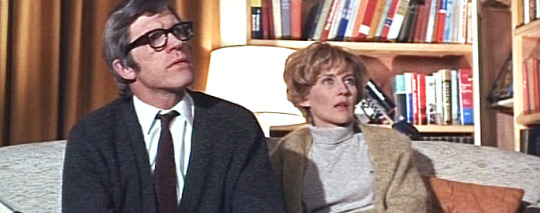
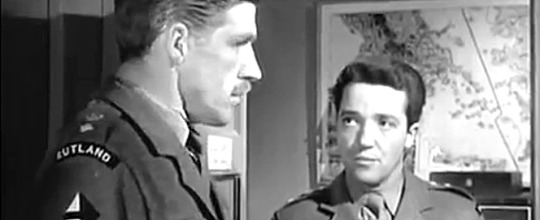
[James Maxwell in Otley (1969) with Phyllida Law (playing husband and wife), and with Eric Thompson in Private Potter (1962).]
It’s also up on the same property website so you can have a nose inside again. (And boggle at London house prices: the 1995 buyer who sold it for 400% profit was clearly onto a good thing.)
3. 37 Matheson Road, W14 (1956)
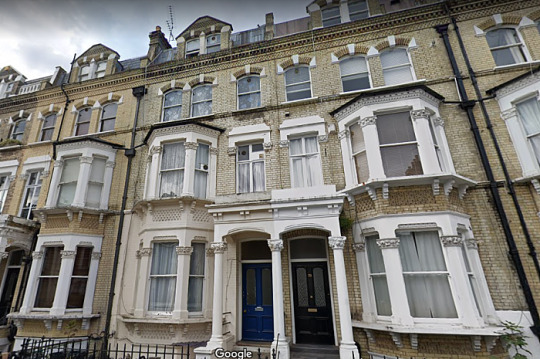
Avril Maxwell was listed here, along with Coral & Horace Birby, Albert J Goode, Kathleen M. Kennedy, Joan Macpherson & Muriel Parrington.
It still has four floors of separate flats, one of which currently appears to be occupied by a care agency.
(I believe this is the right person, but it’s the only time she’s listed as “Avril Maxwell”(no ‘E’). This address is the outlier, in name & location; please consider this yr friendly disclaimer.)
4. 17 Lymington Road (1959, 1962, 1963)
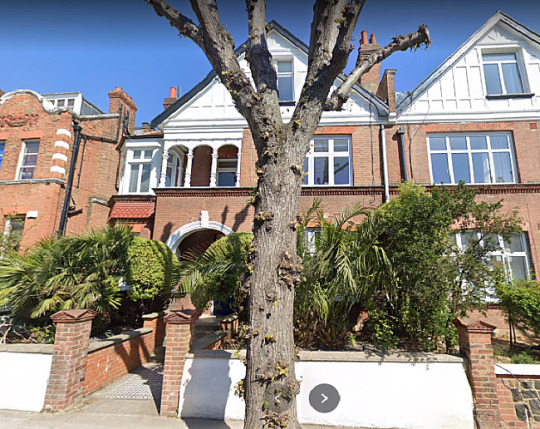
[Pretty sure this must be no. 17 Lymington Road, centre here. 15 is the one to the left, I think.]
It isn’t listed on the same property site (unfortunately), but it is currently still divided into flats.
In 1962 & 1963, Eric & Phyllida Thompson were again living close by at no.15 Also at no. 17 were Gordon & Gillian Murray, and Edith & John O’Sullivan.
This means that when they were making Private Potter presumably Eric Thompson got to see JM first and last thing looking normal and then spent all day with him looking like this:
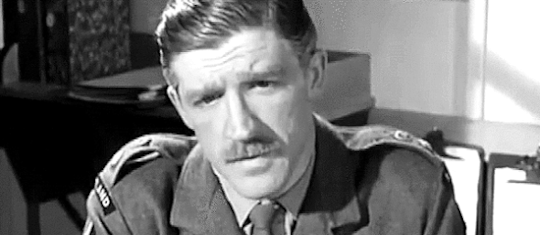
[gif of James Maxwell in fake eyebrows & moustache]
Which seems a bit much to ask of anyone, really.
5. 21 Temple Fortune Court, Temple Court Lane, NW11 (1964, 1965)

[Temple Fortune Lane, 1965, courtesy of the Francis Frith collection.]
For the first time, Avril E. Maxwell is the only person listed at the address, so it looks as if they were both finally doing well enough to afford a place of their own.
Ancestry’s London Electoral Rolls collection stops at 1965, but if they were still there in the following year, then Temple Fortune Court is where this ‘at home’ photograph was taken, in March 1966 (he’d just been playing Claude Frollo for the BBC, which I think explains the strange hair):
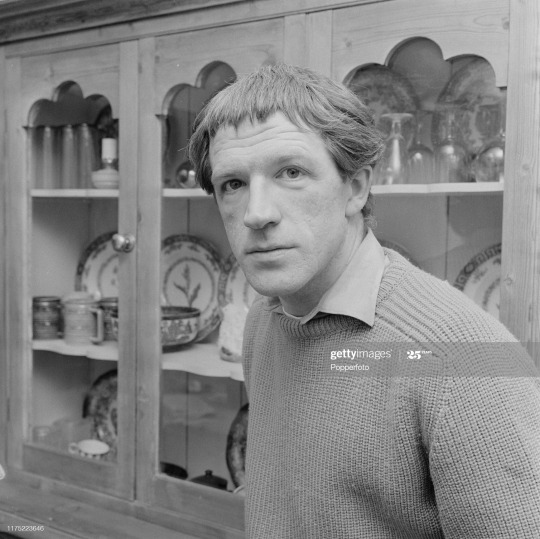
It’s hard to say much about 21 Temple Fortune Lane because it is now a brand new block of flats. (The design company seem pretty proud of it at least).

It’s visible on this 1950 Ordnance Survey map, though - it can’t have been a block of flats in 1964-5 with only one person listed at the address, but it seems here to be surrounded by communal space and buildings rather than a private garden. The ‘Temple’ is a real one - it’s a Jewish area of London, with a temple and a Jewish cemetery nearby.
James Maxwell said that he didn’t have a celebrity life - that he much preferred to be at home, with his his family and his garden, but it took a lot of years of moving around from one flat to another before that could be a reality, and it seems that began with the move to Temple Fortune.
[sources: UK Passenger lists London Electoral Rolls collection, Ancestry.co.uk; US Passenger lists, ancestry.com; TheMove; Google Street View; Francis Frith Collection; Getty Images; The Underground Map.]
#james maxwell#james maxwell research posts#1950s#1960s#eric thompson#phyllida law#avril elgar#lambeth#norwood#south london#private potter#otley#dulwich#gif#fulham#house history#i was trying to decide whether this one was too boring to post#or the most interesting because of nosing around in older houses#long post#actually one other showbiz name that crops up is gordon murray#but much as i would like to claim that jm shared an address with the person who came up with camberwick green#his wife was called enid#and i don't know why he would be in digs with someone called gillian#and it's a common name#(i feel i should have looked all the other names up more#but none of them got google results & its very hard indeed to find people just off elelectoral rolls#BUT i can reveal that Leokadia Dixon was born in 1918 and died in 2000 but even with that name that's all i got
14 notes
·
View notes
Photo
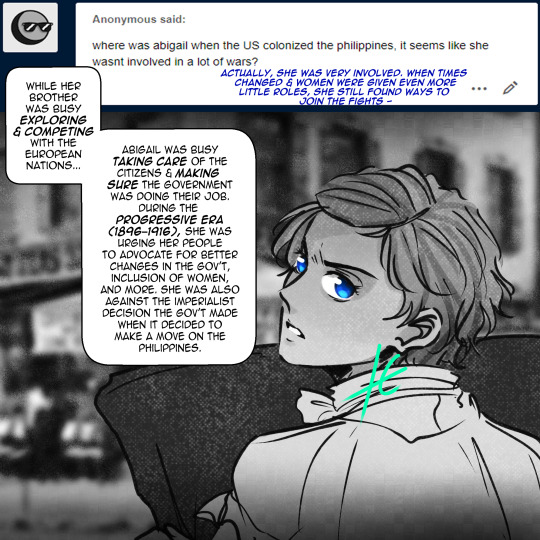
:::HISTORY TIME:::
The Progressive Era (1896–1916) was a period of widespread social activism and political reform across the United States of America that spanned the 1890s to the 1920s. Progressive reformers were typically middle-class society women or Christian ministers.
The main objectives of the Progressive movement were addressing problems caused by industrialization, urbanization, immigration, and political corruption. Social reformers were primarily middle-class citizens who targeted political machines and their bosses. By taking down these corrupt representatives in office, a further means of direct democracy would be established.
They also sought regulation of monopolies (trustbusting) and corporations through antitrust laws, which were seen as a way to promote equal competition for the advantage of legitimate competitors. They also advocated for new government roles and regulations, and new agencies to carry out those roles, such as the FDA. The Progressive Era played a pivotal role in US history.
Initially, the movement operated chiefly at the local level, but later it expanded to the state and national levels. Progressives drew support from the middle class, and supporters included many lawyers, teachers, physicians, ministers, and business people.
Some Progressives strongly supported scientific methods as applied to economics, government, industry, finance, medicine, schooling, theology, education, and even the family. They closely followed advances underway at the time in Western Europe and adopted numerous policies, such as a major transformation of the banking system by creating the Federal Reserve System in 1913 and the arrival of cooperative banking in the US with the founding of its first credit union in 1908.
Reformers felt that old-fashioned ways meant waste and inefficiency, and eagerly sought out the "one best system".
REFERENCES:
1. John D. Buenker, John C. Boosham, and Robert M. Crunden, Progressivism (1986) pp 3–21
2. James H. Timberlake, Prohibition and the progressive movement, 1900–1920 (1970) pp 1–7.
3. David W. Southern, The Malignant Heritage: Yankee Progressives and the Negro Question, 1900–1915 (1968); Southern, The Progressive Era And Race: Reaction And Reform 1900–1917 (2005); Norman H. Clark, Deliver Us from Evil: An Interpretation of American Prohibition (1976) p 170; and Aileen Kraditor, The Ideas of the Woman Suffrage Movement: 1890–1920 (1967). 134–36.
4. McGerr, Michael. A Fierce Discontent: The Rise and Fall of The Progressive Movement in America. Oxford University Press. p. 77.
5. Joseph Dorfman, The economic mind in American civilization, 1918–1933 vol 3, 1969
6. Barry Karl, Charles E. Merriam and the Study of Politics (1975)
7. George Mowry, The California Progressives (1963) p 91.
8. Daniel T. Rodgers, Atlantic Crossings: Social Politics in a Progressive Age (1998)
9. Michael Kazin; et al. (2011). The Concise Princeton Encyclopedia of American Political Turn up History. Princeton University Press. p. 181. ISBN 9781400839469
10. Richard Hofstadter, The Progressive Historians: Turner, Beard, Parrington (1968).
#PLANETPUTO
BLOG: ask-emilz-de-philz.tumblr.com
17 notes
·
View notes
Text
Book Recs for Magnus Archives Fans
I was just rambling in tags the other day about how my avatarsona was "the Archivist, but a public librarian: Oh, you like dirt?? Let me tell you all the dirt stories I have!!!!" so, uh, here I am I guess.
I'm gonna spare you all the M.R. James and Algernon Blackwood and House of Leaves and Blindsight; you know all that already. These are my horror backlist recs.
The Bone Key by Sarah Monette Y'all. Y'ALL. Kyle Murchison Booth was absolutely the Archivist before Gertrude. He was poached from the Parrington by the Usher Foundation and the Eye glommed onto him at once, because the Eye loves disaster queers who can't people right (and also Gertrude). This I believe to be true, and so will you.
Kyle Murchison Booth is an archivist at the Parrington Museum, which is somewhere in New England, sometime in the early twentieth century. He also has a lifelong entanglement with the supernatural which is almost entirely not his fault, and he would very much like it to stop, but he also feels responsible and he can't just let evil mirrors and cursed necklaces and possessed dressing gowns randomly eat people who have no idea what's happening. Even if it means he's going to suffer for it.
(This collection doesn't contain all of the Booth stories, so here I am going to link to "White Charles", which happens to be my very favorite Booth story.)
For you if your favorite part is: honestly everything about MAG, from the modern sensibilities about early twentieth-century-horror, truly eerie ghost stories, to suffering eldritch librarians (thanks to whoever tagged my most recent fic with that you're so valid), monsterfucking and soft gay pining. No happy endings here, sorry.
Bedfellow by Jeremy C. Shipp You may or may not have heard that Macmillan-Tor is launching a horror imprint, and I don't know how long it's been since a major publishing house has had a horror imprint, but I am EXCITE. This book is part of the trend that's the reason why: Tor.com has been publishing these kickass novellas for a couple years now, and their horror books are top notch.
One night a stranger knocks on a family's living room window and asks to be invited in. They ask him to stay the night. He's an old friend, after all, he needs a place to stay. You can't kick out your twin brother when he's just gotten divorced, no matter how much Gatorade he spills on your two-year-old hardwood floors.
For you if your favorite part is: the Stranger, this is all Stranger, it's terrifying and good.
Through the Woods by Emily Carroll A graphic novel, some of these were originally posted as webcomics (have you seen His Face All Red, and if not, why not???) and the only disadvantage to having them in book form is they can't blink at you. Probably. Very folktale-ish, with all the death and violence that implies, and also the slightly eerie feeling that you know this story already, and then it turns around and slaps you.
For you if your favorite part is: looking over your shoulder when the foley gets good; Once Upon a Time in Space (I know that's not technically part of the Magnus Archives but shush)
Universal Harvester by John Darnielle I am not usually a fan of artists who jump media. Just because you can write songs doesn't mean you can write novels. Apparently writing good songs doesn't mean you can't write good novels, though, because John Darnielle of The Mountain Goats (pretty sure that's his full name at this point) wrote Universal Harvester and I love him for it.
Jeremy works at a video rental place in Nevada, Iowa (it's pronounced Nah-vey-da, and yes it’s real, I've been there, and yes, it's probably haunted). It's the 1990s, and someone's been returning their VHS tapes with something on them that isn't just the movie. Footage that includes a barn that he recognizes, just outside of town.
Fair warning: this is not the kind of mystery that gets tied up in a nice bow at the end.
For you if your favorite part is: Jon losing it with paranoia in S2, The People's Church of the Divine Host, the Lonely
The Good House by Tananarive Due If this author's name is unfamiliar to you, RUN, do not walk, to your nearest internet bookseller and purchase every single one of her books immediately, you will not regret it. She also just came out with a documentary on black horror, Horror Noire, on the Shudder streaming service. They've got a free month if you aren't a horror movie person, it'd be worth your while. This book summary sounds like it's full of tropes. It is, but Due has the cred to write them well.
Angela Toussaint hopes to salvage her suffering marriage and her troubled relationship with her teenage son with a trip to her grandmother's house, a home so beloved the locals in small-town Washington state call it "The Good House," but tragedy strikes instead. Two years later she returns and finds that the tragedy isn't over, and it's not going to stop on its own.
For you if your favorite part is: the very practical statement-givers who know what's happening to them and Will Not Put Up With This Shit, the Desolation, the Hill Top Road statements
The Library at Mount Char by Scott Hawkins Is this horror disguised as fantasy? Found family disguised as horror? Grown-up Neil Gaiman? Less grimdark George R.R. Martin? Honestly I have no fucking idea, but it's amazing. Fair warning, unlike Magnus Archives, this deserves all kinds of trigger warnings, including but not necessarily limited to: sexual assault, torture, mental manipulation, dysfunctional families, incest(?)
Father is missing, and his twelve children (though extremely talented in their own ways, and not strictly speaking children any more) are at a loss without him. But also, without him, things are starting to seem different. He might be God? They might not be human? (They were probably human once.) He might not be God but maybe one of them might be next? If any of them survive.
For you if your favorite part is: slowly turning into a monster, the relationships between entities and avatars, monsters hot (not kidding about the trigger warnings)
The Loney by Andrew Michael Hurley I have to keep reminding myself that Magnus Archives isn't really folk horror, there are two separate (if related) strains of British horror here and folk horror is not the one we're on, but at the same time I really want a good creepy rural pagan cult to show up in the series, you know? Anyway.
When he was a child, our narrator used to go with his family on an Easter pilgrimage to shrine on a bleak stretch of Lancaster coastline locals called The Loney. His Catholic mother was searching for a cure for his older brother, and she was convinced if they kept going long enough she would be granted her wish. The locals, however, are not huge fans of her annual visits, and even less so when the boys become involved with the goings-on of a pair of glamorous tourists.
For you if your favorite part is: the Lukases, I didn't realize until I was writing this up that I'm picturing Moreland House in the exact place described by this book
Eutopia by David Nickle One thing I love about the historical statements in Magnus Archives is just how truly historical they are. There's almost nothing in "The Piper" that isn't historically accurate - yes, Wilfrid Owen spent several days in a trench underneath the shredded bodies of his fellow soldiers. Like. You can't make up horror worse than that. But then you add monsters and it gets good. And I'm a sucker for early-twentieth-century history, it's such a bonkers time.
It's 1911 and the new Eugenics Record Office is sending agents out to catalog the disabled, infirm, and otherwise undesirable members of society so they can figure out what to do about them. In the utopian town of Eliada, Idaho, Dr. Andrew Waggoner runs from the racism of American society and straight into the influence of Mister Juke, the most troubling patient in his new practice. (Trigger warnings for, obviously, a whole lot of ableism. Treated like the monstrousness it is, but there's a lot of it.)
For you if your favorite part is: learning history through horror, the Flesh
A Head Full of Ghosts by Paul Tremblay I hate male writers writing about teenage girls, so you are going to have to trust me when I say that I had to check, several times while reading this book, to make sure that Paul Tremblay is actually a dude. He's very good. This book was kind of his breakout, so if you follow horror you've read it already, but if you don't necessarily then please do not miss it. His newer ones, Disappearance at Devil's Rock (Stranger, Spiral) and The Cabin at the End of the World (Slaughter, Extinction), are also good but not as good as this, I think.
Fourteen-year-old Marjorie is having a rough time - outbursts, hallucinations, paranoia. Treatment is difficult (and expensive) and her family ambivalent; they turn to a local Catholic priest, who recommends an exorcism and, to help manage those medical bills, a production company who's interested in filming a reality TV show about the process. Fifteen years later, Marjorie's sister deconstructs the now-famous show and wrestles with her own memories of childhood. Trigger warnings for ableism on the part of many of the characters, but not the narrative.
For you if your favorite part is: the Spiral, metafictional analysis of horror tropes
#the magnus archives#book recs#there's a lot of other things i could tag this as#but i wrote it for this fandom#is this a transparent excuse to get more people to read booth stories??#it is#it really is
515 notes
·
View notes
Text
Men at Work

‘Notions of American masculinity have long drawn on a shallow pool of tropes, most of which we tend to associate with fictionalizations of the frontier: the lonesome swagger of John Wayne, the gruff reticence of the cowboy. But up until the end of the nineteenth century, the ideal of American masculinity was far more communal. The historian E. Anthony Rotundo has observed that the masculinity of the colonial era wasn’t defined by chest-thumping machismo or brawny, entrepreneurial pluck, but was measured instead by a man’s willingness to forfeit his time and resources for the betterment of his community. Hardly was this a matter of ‘emotional intelligence.’ Rather, his duties were fulfilled through “publick usefulness.” Often this led to nascent forms of mutual aid, because in a world where ‘creditors were neighbors and kinsmen were clients, a man’s failure at work was never a private concern.’ Meanwhile, those men who saddled up and lit out for the territories were roundly condemned as ‘frontier wastrels,’ as the historian Vernon Louis Parrington called them, princes of thoughtlessness who pursued their own agendas and roamed the country as they pleased.”
“Yet the rise of industrialization and the birth of modern capitalism rewarded precisely those attributes that colonial communities were prone to denigrate: aggression, guile, and an overwhelming will to power. Even when men failed to thrive in the marketplace, they nevertheless succumbed to its sanctioned forms of masculinity. The feminist scholar Joseph Pleck notes that during the Great Depression men no longer had access to the sorts of external achievements that once granted them a stabilizing dose of virility—wartime brawn or financial independence—so they deferred instead to psychological or behavioral attributes to restore their sense of identity. Lacerated by the dehumanizing conditions of the factory, male workers typically responded with a cocksure ‘hardhat culture,’ as the writer Pankaj Mishra calls it, whereby heavy drinking, coarse language, and prurience became tokens of masculinity, a conception that Mishra believes has ‘reached deep into blue-collar workplaces during the decades-long reign of neoliberalism.’”
Of course, it’s breathtakingly naïve to think that therapy alone would be enough to redress the larger systemic forces behind a problem like toxic masculinity. But this hasn’t stopped a whole plethora of personalized remedies from getting pitched to men as a tonic—a new membership with CrossFit, a cathartic jaunt to Burning Man, a weekend retreat in the woods to recover his “deep masculine.” ‘Popular accounts of the male crisis and male confusion,’[Susan] Faludi {author of Backlash] writes,
‘are unrelievedly a historical. The conditions under which men live are ignored and men themselves are reduced to a perennial Everyman . . . How would men’s problems be perceived, though, if we were to consider men as the subjects of the world, not just its authors?’”
Harper’s Magazine, November 2019: “Men at Work: Is there a masculine cure for toxic masculinity?” by Barrett Swanson
#masculinity#toxic masculinity#America#industrialization#neoliberalism#Evryman#emotional intelligence
2 notes
·
View notes
Text
How do a serial killer's mind function and the story of Ted Bundy
According to John Parrington, “serial killers characteristically lack empathy for others, couples with an apparent absence of guilt their actions. At the same time, many can be superficially charming, allowing them to lure potential victims into their web of destruction.
Ted Bundy
Background story
Born on November 24, 1946, Ted Bundy. In Burlington, Vermont, he was raised. He is well-known as a rapist and serial killer in America. An infamous criminal from the late 20th century was also among them. He was diagnosed as a psychopath. Bundy was raised in a very strict environment with numerous issues of abuse and violence, which had an impact on his development. But later in life, he had a successful academic career due to his intelligence and social abilities, and he also formed a number of seemingly typical emotional relationships with women. Despite his seeming stability, he killed several young women and sexually assaulted others in Washington, Oregon, Colorado, Utah, and Florida.
In the end, Bundy admitted to killing 36 young women in several states during the 1970s. Now, according to analysts, the final number may be closer to 100 or maybe more. It will never be established how many women Bundy killed. He killed in a grisly manner that was consistent. Before beating them to death, he frequently raped his victims. Around 1974, Bundy began his killing spree. Many women in the Seattle area and surrounding Oregon went missing during this time. He frequently pretended to be hurt in order to get his vitcims to go in his car.
When Bundy relocated to Utah in the fall of 1974 to start law school, women also started going missing there. He was stopped by the police the next year. A search of his car turned up ropes, handcuffs, a face mask, burglary tools, and a crowbar. Police started to wonder if this was connected to the heinous acts when he was caught for possessing these tools.
How did Ted Bundy escape prison?
In 1977, Bundy made two prison breaks. The first time, he made the decision to represent himself in court after being charged with murder in the death of a young Colorado woman. He made his initial escape by jumping through a window while visiting the courthouse library. Eight days later, he was apprehended. Bundy fled from custody once more in December. He lost more than 30 pounds to squeeze through the tiny entrance and climbed out of the hole he had created in his cell's roof. Bundy had a significant advantage against the police since this took 15 hours for authorities to discover that he was missing.
The murder of Chi Omega Soroty House
Following his second prison break, Bundy eventually traveled to Tallahassee, Florida. On January 14, 1978, Bundy broke into the Florida State University Chi Omega sorority house. He killed two of the four young female residents after attacking them. Kimberly Leach, 12, was kidnapped and killed by Ted Bundy on February 9.
Trail and Death
Due to his intelligence, Bundy gained some notoriety during his trial. Despite fighting for his life, Bundy was ultimately found guilty and sentenced to death after nine years of incarceration. Bundy was found guilty of the two Chi Omega murders at FSU in July of 1979. He twice received the death penalty. In 1980, he was given a second death sentence for the murder of Kimberly Leach. Ted Bundy was put to death in an electric chair at the Florida State Prison on January 24, 1989.
0 notes
Text
The Deeper Genome - John Parrington
The Deeper Genome Why there is more to the human genome than meets the eye John Parrington Genre: Life Sciences Price: $9.99 Publish Date: October 6, 2017 Publisher: OUP Oxford Seller: The Chancellor, Masters and Scholars of the University of Oxford trading as Oxford University Press Mapping the human genome proved to be just the beginning in understanding our genes, what makes us human, and how we can use the knowledge to cure inherited diseases. John Parrington describes an emerging picture of our genome, in 3D, with many non-gene players and environmental influences, that is far more complex and subtle than we ever imagined. http://dlvr.it/R1RXcH
0 notes
Text
Vernon Louis Parrington Kimdir?
Vernon Louis Parrington Kimdir?
(d. 3 Ağustos 1871, Aurora, Illinois, ABD – ö. 16 Haziran 1929, Winchcombe, Gloucestershire, İngiltere), ülkesinin düşünce yaşamında etkili olmuş ABD’li edebiyat tarihçisi ve öğretmen.
Harvard Üniversitesi’ni bitirdikten sonra College of Emporia ile Oklahoma (Nor-man) ve Washington (Seattle) üniversitelerinde ders verdi (1893-1929). William Morris ile John Ruskin’den, Taine’in eleştiri…
View On WordPress
0 notes
Link
0 notes
Photo


Genome editing on the new book shelf:
“Caitlin Shetterly discovered the importance of GMOs the hard way. Shortly after she learned that her son had an alarming sensitivity to GMO corn, she was told that she had the same condition, and her family’s daily existence changed forever... Modified is a rare breed of book that will at once make you weep at the majestic beauty of our Great Plains and force you to harvest deep seeds of doubt about the invisible monsters currently infiltrating our food and our land and threatening our future.”
“Since the birth of civilisation, human beings have manipulated other life-forms. We have selectively bred plants and animals for thousands of years to maximize agricultural production and cater to our tastes in pets. Powerful new techniques also raise important ethical dilemmas and potential dangers, pressing issues that are already upon us given the speed of scientific developments. John Parrington explains in Redesigning Life the nature and possibilities of these new scientific developments, which could usher in a brave, new world. We must rapidly come to understand its implications if we are to direct its huge potential to the good of humanity and the planet.”
#oberlin college#oberlin college libraries#GMO#genome editing#genetically modified organisms#newbooks
0 notes
Photo

JSIS 478H LGBTI Rights in International AffairsInstructor: Dr. Elise Carlson-RainerEmail: [email protected]: Tues, Thurs 12:30- 2:20, Spring 2017ROOM: ROOM: MEB 250 During this course, students will examine the intense global debate over LGBTI equality norms and how it impacts international affairs. Discussions will address how human rights concepts have evolved, strategies of social movements, and how states influence one another based upon normative values. Through guest speakers, group projects, and policy simulations, students will gain experiential learning of human rights advocacy. The course offers an overview of LGBTI rights in international affairs, U.S. and E.U. human rights foreign policies, and contemporary debates in the UN on global rights. Class participants will investigate NGOs and civil society advocacy strategies that lead to foreign policy reform, Sweden’s feminist foreign policy, and how human rights is, or is not, prioritized over security interests. The course ends with a negotiation simulation of the U.S. conditioning aid to Uganda based upon LGBTI rights abuses. Exciting Opportunity!: Students will meet the U.S.’ first-ever Special Envoy for the Human Rights of LGBTI People appointed by Secretary of State John Kerry. Caitlin Blomquist, M.Ed.Academic Program ManagerEvans School of Public Policy & Governance | University of Washington109 Parrington Hall | Box 353055 | Seattle, WA [email protected] | 206.616.1613Prounouns: she/her/hersSchedule an academic advising appointment Connect with us on Facebook and Twitter
0 notes